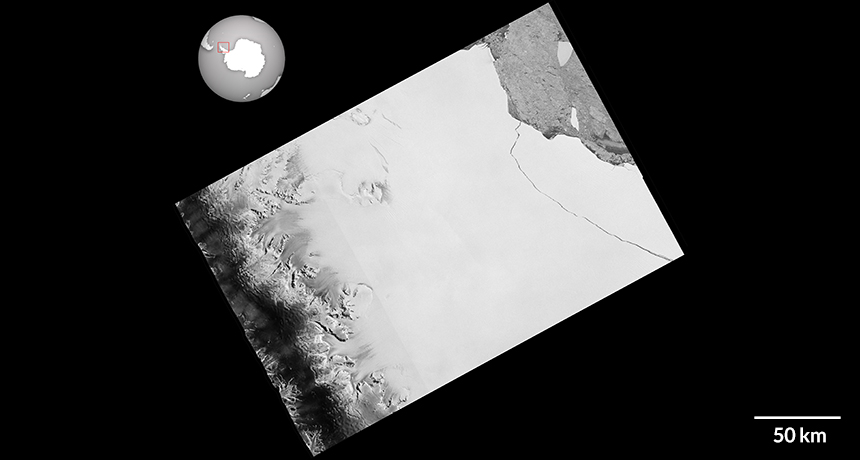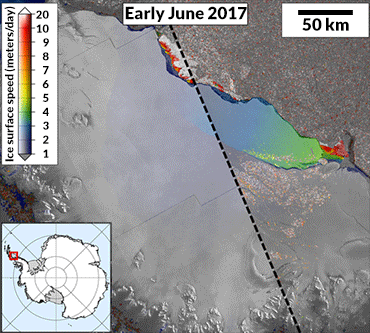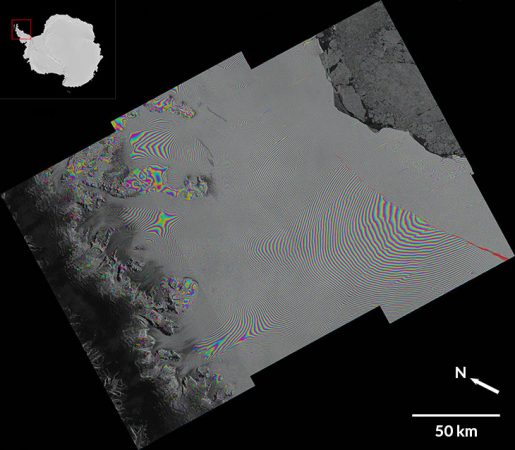Antarctic ice shelf sheds Delaware-sized iceberg
The ice chunk’s release raises questions about how stable its parent ice shelf is

Images from the European Space Agency’s Sentinel-1 satellites confirm the crack of Larsen C has reached the Weddell Sea, allowing an iceberg weighing 1 trillion metric tons to calve.
ESA (CC BY-SA 3.0 IGO)
With one last rip, a roughly trillion metric ton iceberg splintered off of Antarctica’s Larsen C ice shelf today. The event had been anticipated for weeks. A fracture on the ice shelf had been growing, day by day. It finally calved off a chunk of ice roughly the size of Delaware. This is one of the largest ice-shedding events ever reported.
July 12 satellite images confirmed that a nearly 5,800-square-kilometer (2,240 square mile) iceberg had separated and was floating in the Weddell Sea. Its size is equal to about a tenth of the ice shelf’s starting area.

Scientists had been monitoring Larsen C since 2014. Back then they had noticed that a surface crack had grown roughly 20 kilometers (12.5 miles) in less than nine months. The cracking slowed in 2015. Then it grew another 40 kilometers in 2016, and 10 more in the first half of January 2017. The crack had now spanned a distance of 175 kilometers (108 miles). Its tip was just 20 kilometers from the Weddell Sea.
In late May, approaching winter there, the crack lengthened 17 kilometers more. At times, its leading edge extended parallel to the ice shelf, leaving it still 13 kilometers from the sea’s edge. The crack forming the edge of this soon-to-be iceberg was so big that it essentially left the enormous hunk of ice dangling. That meant it could move separately from the whole shelf. And this put new pressure on the entire ice shelf, and especially the crack.
“The remaining ice is strained near to breaking point,” Adrian Luckman tweeted June 30. “It won’t be long now,” added this scientist at Swansea University in Wales. He’s a glaciologist who has been keeping an eye (via satellite) on the crack.
By July 6, the crack had come to within 5 kilometers of the edge of the ice. Earlier today it reached the water, allowing the huge hunk of ice to become a free-floating iceberg.
The ice loss dramatically alters the landscape of Larsen C, Luckman notes. “Maps will need to be redrawn.”
More drama to come?
But today’s ice release could be the least of the troubles ahead, says Adam Booth. He’s a geophysicist at the University of Leeds in England. “The calving event is significant because it is likely a precursor to something much bigger,” he says. He could imagine, “potentially, the collapse of the whole Larsen C ice shelf.”
That’s what happened, 15 years ago, to the neighboring Larsen B ice shelf shortly after it calved off a Rhode Island-size iceberg.
“Glaciologists are keen to see how Larsen C will react,” says Luckman. Together with Booth, he has been monitoring Larsen C as part of Project MIDAS. The project uses research on the ground and from satellites along with computer analyses to track impacts of a warming climate on this ice shelf.
Since ice shelves float on water, the calving of icebergs from them won’t directly raise sea level much (and only then when the whole berg has melted). But a complete collapse of Larsen C would be a different matter. The reason: Ice shelves get in the way, and thereby slow the flow of ice off of Antarctica’s land. The calving or collapse of ice shelves allows glaciers and ice streams further inland to now flow unimpeded into the ocean. And that can contribute to sea-level rise.
Calving of icebergs is common. Over several decades, ice shelves will usually return to their original size. But in the last two decades, ice shelves have instead continued to lose ice — until they finally collapse. This likely reflects Earth’s rising fever, due to climate change, the researchers say. In 2014, scientists concluded that Larsen B’s collapse was due to such warming.
Some computer modeling studies in 2015 suggested that Larsen C could suffer the same fate, Luckman says. That projection had indicated it could happen within a few years to decades. Still, the calving event that feeds a potential collapse may itself be due to factors other than climate change. “Not all ice-related stories have a clear global warming origin,” Luckman points out. Larsen C’s calving, he says, “may simply be a natural event that would have happened regardless.”
To be sure, not all scientists are certain Larsen C will fall apart completely. Researchers from Europe predict major changes to the shelf would happen only if it loses more than half of its ice. At that point, a Nature Climate Change paper concluded last year, a large share of ice could ooze out of glaciers and into the ocean.
Still, understanding what has just allowed the new mega-calving of Larsen C will “give us insight regarding other fractures or rifts on the shelf,” says Dan McGrath. He’s a geoscientist at Colorado State University in Fort Collins. He considers a total collapse of Larsen C “very unlikely.” But this ice shelf does have other dormant rifts, or cracks. And based on where they sit, he says, if these started growing, any later calving event could “be worrisome for the shelf’s stability.”
Differences in predictions of Larsen C’s future raise an important point, adds Richard Alley. He’s a geologist at Pennsylvania State University in State College. Researchers don’t understand ice shelf calving and collapsing well enough to firmly predict how any one ice shelf will behave after a big part of it breaks away.
“The Larsen C ice shelf is, of course, just one small part of Antarctica,” Booth says. “What is worrying is that we’re seeing trends in several ice shelves that tend towards decreasing stability. Should they continue along these trends, we could be seeing the start of increased mass loss from the Antarctic continent.”
And that could spell big increases in sea-level rise — conditions that would challenge coastal communities across the planet.








